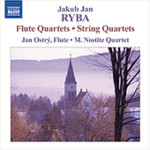
String Quartet / 2 Flute Quartets
 $25.00
Out of Stock
$25.00
Out of Stock6+ weeks add to cart
JAKUB JAN RYBA
String Quartet / 2 Flute Quartets
Jan Ostry / M. Nostitz Quartet
[ Naxos / CD ]
Release Date: Monday 6 November 2006
This item is currently out of stock. It may take 6 or more weeks to obtain from when you place your order as this is a specialist product.
"Flautist Jan Ostrý and the M. Nostitz Quartet are quite well-balanced, with no tendency for the brightness of the flute to overpower. The sound and ambient presence of the recording are warm and distant enough to allow for a sense of space without losing definition. I certainly would recommend this for any fans of Haydn's chamber music."
(MusicWeb May 2007)
Relatively little survives of the instrumental music of the Czech composer Jakub Jan Ryba. Indeed the present four quartets, two for flute, violin, viola and cello and two for string quartet are the only four quartets remaining out of 72 once listed. Ryba was the son of a cantor, a local schoolmaster, and followed his father's profession, one of continuing traditional importance in the fostering of music in Bohemia and the adjacent regions. Born in Přeštice, near Klatovy, in 1765, he studied in Nepomuk with his father and from 1781 to 1785 was a pupil at the Piarist Gymnasium in Prague, before returning home to work as an assistant to his father. In addition to his abilities as a keyboard player, having studied the piano and the organ with his father, as well as the violin, he also played the cello. In 1786 he became an assistant teacher at Mnišek and two years later took up a similar appointment at Rožmitál, where he served as choirmaster until his death by his own hand in 1815.
Ryba's church music, of which there is a considerable quantity, including some ninety Masses, seven Requiems and a hundred or more graduals, motets and other works, represents the largest body of his surviving compositions. For his earlier compositions he used an imaginative variety of names, Poisson, Peace, Ryballandini, Rybaville, which suggest a certain sense of humour. His ambitious works for the Church of St Bartholomew in Pilsen earned him in 1805 the title of honorary citizen. His secular music includes Czech songs and a very large amount of orchestral and instrumental music, now lost. For the useful compilation on Czech music and musicians of the period by the Bohemian Premonstratensian scholar Bohumir Dlabač, choirmaster and librarian at Strahov, Ryba listed among his instrumental works over 650 dances, 130 variations, 87 sonatas, 38 concertos, 35 symphonies and many other compositions. He holds an important position in the Bohemian musical tradition of schoolmasters of his time, fostering the Czech language in musical settings and in musical terminology, and a supporter of the educational reforms initiated under Joseph II. His surviving instrumental music shows the influence of his contemporaries, of composers such as Vaňhal and Mysliveček, and of Haydn and Carl Philipp Emanuel Bach.
The two surviving Flute Quartets date from 1811 and survived in the collection of the Rožmitál Regens Chori Schmelzer. The Flute Quartet in C major starts with a sonata-form movement of transparent texture. After the statement of the main theme the cello has moments of attention, as the key shifts to the dominant for the second subject. Here, in the central development and in the recapitulation, each instrument is allowed its due share of interest. The F major slow movement, marked Andante poco adagio, gives the principal theme to the flute, accompanied by the plucked notes of the strings until the short contrasting central section. The quartet ends with a splendidly varied rondo.
The first of the two surviving string quartets, works of equal competence and charm, the String Quartet in A minor, dating from 1801, starts with a movement marked Andante poco adagio, the parts closely interwoven, with ample use made of sequence and contrapuntal imitation, the opening figure retaining importance throughout. The Menuetto that follows, marked Allegretto and in the major, indulges in syncopation and has a contrasting minor-key Trio. Contrapuntal imitation is a feature of the final Allegro.
Ryba's Flute Quartet in F major cannot but suggest bird-calls in the hesitant syncopation of the opening Allegretto and in the dialogue between the flute and other instruments, scale answering scale and figure answering figure in the central development. The second movement is in the form of a Hungarian theme and variations. The first variation gives prominence to the violin, the second in syncopation to the flute, the third to the viola, the fourth again to the flute, the fifth to the cello, and the sixth finally once more to the flute. The cheerful main theme of the final Presto enjoys continuing importance, providing the source for touches of contrapuntal activity as the move- ment progresses towards the little surprises of its codetta.
The String Quartet in D minor also survives in a copy of the manuscript parts of 1801 in the possession of the Bohuslav von Kolovrat family. It opens with a moving Adagio, dominated by its opening figure and closely interwoven in texture, recalling, inevitably, the opening of Mozart's Dissonance Quartet. The second movement, a Minuet, is a cheerful D major canon, started by the first violin, followed by the second violin, viola and cello in order and suggesting a Bohemian origin. It frames a D minor Trio. The final Scherzo presents the main theme in canon, introduced by the second violin, and motivically even suggesting Mendelssohn, although its skilled use of counterpoint is very much of its own place and period.
Tracks:
Flute Quartet in C major
Flute Quartet in F major
String Quartet in A minor
String Quartet in D minor